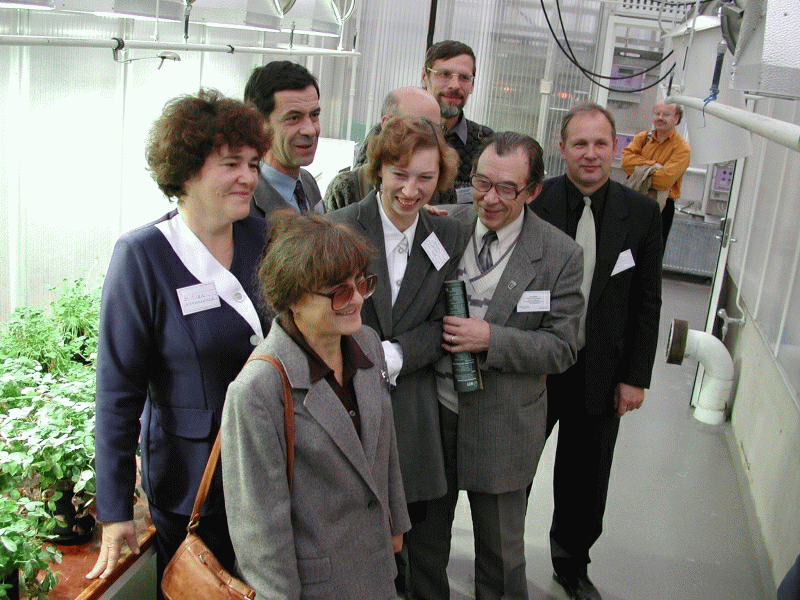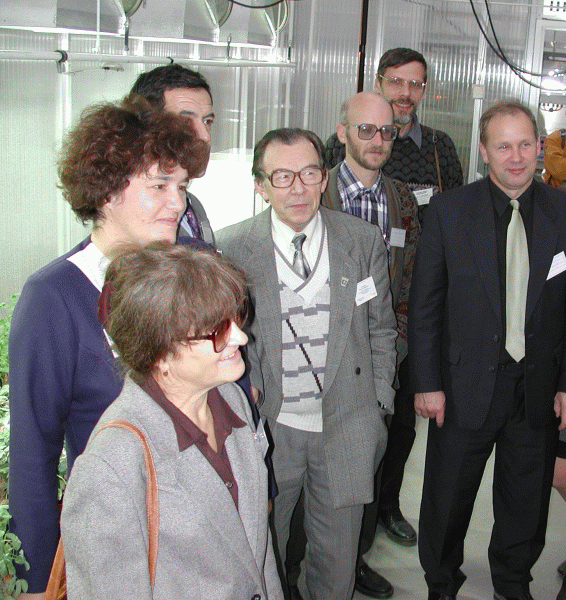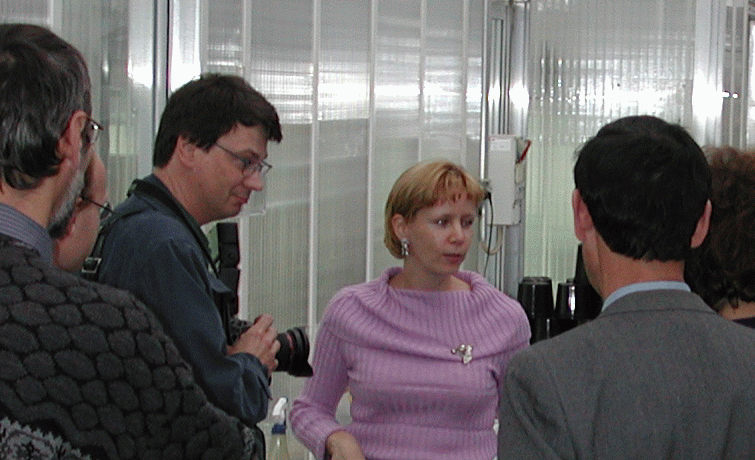|
|
|
|
|
Photos by Jarmo Holopainen |
 |
 |
 |
FORECASTING
AND WARNING METHODS FOR PLANT PROTECTION IN NORTH-WESTERN RUSSIA
BACKGROUND
In
North Western territory of Russia agriculture coexists with natural forests,
lakes, and coastline of Finish bay of Baltic Sea. Many of environmental
problems we are dealing with are common to all Baltic countries community.In
particular Leningrad region is one of agricultural production zones of
Russia.Major cultures are vegetable
crops (mostly concentrated around big industrial centres like St.-Petersburg
and others), potatoesand cereals
(winter rye , barley, oats).Unfortunately,
modern intensive technologies in agriculture can cause soil erosion and
pollution of fresh waters. To meet nature conservation requirements and
to increase output of high quality agricultural production is only possible
with optimal system of plant protection.Within
our Institutions the problem of pesticide pollution is studied in it very
beginning, as in sustainable Plant Protection Systems unnecessary pesticide
treatments will be eliminated.To
minimize the use of pesticides will require better knowledge of insect
population dynamics and tile epidemiology of virus and fungal diseases
as well as economic threshold values. Such information is essential when
developing pest management strategies and in decision-making related to
pesticide treatments, etc. . Other important step in minimizing of pesticide
press in sustainable Plant Protection Systems will be use of unsusceptible
varieties of potatoes, cereals and other cultures of Russia and Finland
breeding in agriculture .Essential
is also pesticides residuals monitoring in agricultural production. So,
study of ecosystem function, use of unsusceptible varieties, use of more
environmental friendly pesticides of new generation, monitoring of pesticide
residuals in agricultural production are needed for overcoming major problems
of agricultural pests and diseases outbreaks, pollution and soil erosion.
Over
the last 10 years in Russia there has been increased interest in developing
forecasting methods as well as in developing an effective warning system
for pests and diseases.It is essential
to implement their positive experience for lager territories within Baltic
Region.All modern progressive features
ofsustainable plant protection
system in agriculture will be used in education process.
FORECASTING
AND WARNING SERVICE IN RUSSIA
The
Forecasting and Warning Service in the USSR was established in 1957. This
service was organized for work with large collective and state farms. In
general system still function within old structure. Phytosanitary information
from collective farms is concentrated in District Plant Protection Stations,
that are responsible for information from the whole district. Higher level
is Plant Protection Station in region (oblast), responsible for information
from several districts.Regional
Plant Protection Station gets information from all districts, belonging
to region and, when it is necessary,agronomists
inspects fields in the districts, helps with pests and diseases monitoring
.Regional Plant Protection Stations
prepare the forecast for major crops and diseases in the region.For
instance, in Leningrad region plant protection procedures are planned by
Regional Plant Protection Station, that has branch stations in all districts
of Leningrad region.
Experience
ofFinland shows that centralized
systemfor Pest Monitoring is convenient
and can serve adequately for the needs of individual farming as well.That
is also convenient in solving existing environmental problems. North Western
zone of Russia, and Finland have many of the same pest and disease problems
in different crops.
In
view of the great similarities in agricultural conditions between North
Western zone of Russiaand in particular
Leningrad region, (administrative centre is Saint Petersburg) and Finland,there
should be great potential for successfully adapting Finnish forecasting
and warning systems for use in Leningrad region and in North-West region
of Russia in general.
GENERAL
DESCRIPTION OF AGRICULTURE IN LENINGRAD REGION (RUSSIA)
Leningrad
region (oblast') was formed in 1927. It's territory is 83,9 thousand square
kilometers. The total arable land - 423,8 thousand ha. In 1991 Land reforms
were started. Now there are 216 state agricultural enterprises and joint-stock
companies, 6026 private farms (the size of private farms averages as little
as 9 ha), and 241,3 thousand small holdings. The mains crops cultivated
in Leningrad region are: cereals, potatoes, vegetables, fodder crops, perennial
grasses.
The
most important pests and diseases of various crops are as follows:
Winter
cereals:
Pests:
rodents (Microtus arvalis, M. rossiaemeridionalis), different aphids
(Rhopalosiphum padi, Sitobion avenae, Metopolophium dirchodum),
frit fly (Oscinella frit, O.pusilla
Diseases:
Very destructive diseases include root rots (caused by Bipolar sorokiniana,
Fusarium
spp. ) and leaf spots (caused by Septoria nodorum). Great yield
losses are caused by powdery mildew (Erysiphe graminis), especially in
winter cereals; brown rusts (Puccinia recondita), brown dwarf rust
(Puccinia hordei), and some years also snow mould (caused by Fusarium
nivale).
Spring
cereals:
Pests:
aphids mentioned above.
Diseases:
Leaf spot diseases on barley (caused by Rhynchosporium secalis,
Drechslera
teres, D. graminea. Crown rust on oats: (Puccinia coronifera).
Cabbage:
Pests:
diamondback
moth, pierids, cabbage flies, flea beetles.
Potatoes:
More
then 20 sorts of potatoes are cultivated in Leningrad region.
Pests:
Colorado beetles (Leptinotarsa decemlineata)
Diseases:
Potato virus diseases are transmitted by aphids (Macrosiphon euphorbiae
and Myzus persicae). The main potato viruses are potato virus Y(PVY)
and potato virus x (PVX), causing mosaic symptoms; sometimes S and M viruses
are found. In last years diseases causing by viroid organisms are found
too.
The
most destructive disease in potatoes is late blight( caused by Phytophthora
infestans).Black scab (Rhizoctonia solani), ordinary scab (Actinomyces
spp.) are also an important problem. Early blight of potato ( Alternaria
solani) and diseases caused by bacteria, e.g. Erwinia carotovora
var. atroseptica, Clavibacter sepidonicum are comparatively
widespread.
Graminea
grasses:
Pests
in the seeds fields: Glyphipterix simpliciella, Oscinella spp., Rhopolosiphum
padi, Rhopalomyzus lonicerae, Metopolophium dirchodum, Leptoptera dolabrata,
Lygus rugulipennis, Stenodema calcaratum. Diseases: Leaf spots(caused by
Drechslera dictyoides, D. bromi, Ascochyta spp., Mastigosporium calvum,
M. album, Selenophoma donacis, Fusoma triseptatum), ergot (Claviceps purpurea),
disease of stems (caused by Epichloe typhina), powdery mildew (Erysiphe
graminis).
Clover:
Pest
in the seeds fields - Aphion apricans;
Diseases:
crown rot of clover (caused by Sclerotinia trifiliorum), root rot(
Fusarium
spp.).
Oilseed
rape
Diseases:
Sclerotinia
stem rot, caused by Sclerotinia sclerotiorum (Lib.) de Bary,
is economically important disease on spring sown oilseed rape. . Abundant
precipitation during spring and early summer often causes high incidence
of Sclerotinia stem rot. Grey mould (Botrytis cinerea)on
rape seed, is an important disease in North Western zone of Russia. The
spread of disease depend on a number of risk factors.Plant
residuals, containing mycelium or sclerotia of fungusmakes
the source of infection..
Strawberry
Grey
mould (Botrytis
cinerea), is a serious disease on strawberry plantations in Leningrad
region. The spread of disease strongly depend on weather factor, while
high plants density plantations favours further infection.
FORECASTING
SYSTEMS IN LENINGRAD REGION, Russia
The
Regional Plant Protection Station at Saint Petersburg contains about 10
small forecasting and diagnostic stations, evenly located in Leningrad
region. Forecasting specialists, each using identical methods, inspect
fields of all the main crops. They carry out field phenological observations
and search for early symptoms of diseases and signs of impending pest outbreaks.
Specialists from the Forecasting and Diagnostic Laboratory transfer information
to plant protection agronomists in the districts.
At
the moment this service provides mainly diagnostic and warning information,
but there is a great need of additional information and implementation
of methods in plant protection.
Existing
system is mainly oriented on chemical methods of plant protection. New
farmers, some of whom have no agricultural education, are not familiar
with effective pest management practices and can use pesticides inadequately.To
safe environment within Baltic Region, it is, consequently, essential to
develop new forecasting methods and an effective warning and information
systems. Farmers needs good advice so that they can, when possible, avoid
the unnecessary use of chemicals and got familiar with ways of sustainable
agriculture.
Improving
of forecasting methods in Laboratory for Phytosanitary Monitoring and Forecasting
VIZR, Russia
-the
model on rodent densities fluctuation in modern agricultural systems
and their impact in orchards and winter cereals
-Development
of technology of monitoring of cereal aphids in Leningrad region:
-1)
verification of economic threshold for cereal aphids as a major pest on
cereals
-2)
estimation of species composition of main cereal aphids entomophages and
of their thresholds density, that can significantlyreduce
aphids
populations
-3)
selection of chemical means of plant protection less harmful to entomophages
and environment
-favourable
conditions for spread of potato late blight are specified on the
basis ofweather data, that is got
with the help of Austrian automatic meteorological station KMS-P.
-Improving
of integrative protection of vegetable crops on the basis of pheromone
monitoring
-diamondback
moth (Plutella
maculipennis) migrationis studied
as a factor of population dynamicand
mass breeding of this moths in Northern parts of its habitats . Pheromone
traps, provided by Estonian “Flora” Co are used for pest monitoring.The
ways of pest migration in Southern countries (Ukraine, Belorussia) , Northern-Western
zone of Russia and Scandinavian countries is to be studied.
FORECASTING
AND WARNING SYSTEMS FOR PLANT PROTECTION IN RUSSIA
The
Institute of Plant Protection is responsible for forecasting and warning
methodology in Russia. The main objectives of the institute are to develop
and to implement methods for forecasting populations of different pests
and diseases in various crops to limit the use of chemicals in agriculture
to cases where there is an economically justifiable need.
It
is also important to develop an effective warning systems for pests and
diseases. The Institute of Plant Protection is responsible for coordination
within Russia, but the routine work is carried out by regional plant protection
officers at the Agricultural Ministry. A number of methods have been developed
or are under development for various crops:
-A
method to forecast codling moth population on apple based on weather
data (accumulated day-degrees) and trap catches has been used for many
years. The method makes it possible to predict where and when pesticide
applications will be necessary.
-Predictions
of risk for spread of potato virus are partly based on trap catches
and a simulation model developed at the Institute of Plant Protection.
The proved vector for Russia is Rh. padi. The forecast for spread
ofvirus diseases is made by taking
into account the vector efficiency of a given aphid species along with
the timing of its main flight period and the number of individuals migrating.
The model input includes proportions of virus sources, the efficiency of
various aphid species as vectors and mature plant resistance
-Forecasting
methods for various aphid species have been developed which are
based on color trap catches and winter egg counts. Rh.padi
is the most important aphid species on cereals, and S. avenae is
also of some importance in north-western Russia. In Russia suction traps
are used for about 5 years to relate numbers of autumn and spring migrating
aphids to the intensity of attacks on cereals and other crops, partly to
develop the capability for making long-term forecasts.
-Forecasting
method for potato late blight is based upon weather data and susceptible
of different varieties.
-A
variety of other forecasting methods have been developed or are under development
for a number of pests and diseases.
Co-operation
of Russian and Finnish Plant Protection systems will result in more precise
Pest Monitoring and Forecasting for both countries. An exchange of information
will help in forecasting of aphids attacks on cereals andforecast
of transmission of aphid-borne viruses.That
willhelp to make more precise long-termed
forecast both in Russia and in Finland. The co-operation will also help
to clarify ways of diamondback moth migration .If
vector of pest migration through Russia to Scandinavian countries exists,
the information will be essential for both countries.Cooperation
between Institutions in Finland and Russia will help to compare race composition
of Phytophthora infestance population for Russia and Finland, to
improve forecasting methods for Russia.
MAIN
GOAL OF THE CO-OPERATION
It
has become clear that many aspects of the Finnish findings can be applied
to the situation in Leningrad region. Therefore it should be worthwhile
evaluating modified versions of the Finnish warning systems and forecasting
methods for use in Leningrad region and in North-West region of Russia
in general. Corresponding information systems must be introduced in order
to effectively make use of their methods.
The
main goal of this project is to establish integrated pest management programs
in Russian agriculture, primarily in an effort to minimize the adverse
impacts of pesticides on the flora, fauna, drinking water and environment.Whilst
the use of pesticides is warranted, the type of pesticide is to be carefully
selected, application rates, timing, and mode of application have to be
strictly determined .Unsusceptible
varieties of plants are to be used widely within Baltic region, all agricultural
production must be monitored for pesticide residuals. That will insure
minimization of hazards to human health and environment.
To
reach this goal, effective forecasting and warning systems and information
systems as well as technical and economic support will be needed.